
Historical Privilege: The Narrative
Each quarter, a group of students, faculty, and staff at WWU convene an environmental justice reading group to read and discuss recent texts. This quarter (Winter 2019) the group is reading excerpts from Sharing the earth: An international environmental justice reader (Ammons and Modhumita, eds) and Between the Heart and the Land: Entre el corazón y la tierra (Cardenas and Vázquez, eds.). The following entry reflects the group’s discussion last week.
Historical Privilege: The Narrative
Written by: Hope Peterson and Grace Meersman.
Images by: Sarah Kellogg, Riley Hine and Rachel Elam
The following submission is based off two readings from Sharing the Earth by Elizabeth Ammons and Modhumita Roy.
The first reading is: “Black Women in the Wilderness” on page 172 by Evelyn C. White.
The second one is: “Every Traveler Has One Vermont Poem” on page 227 by Audre Lorde.
We had two more readings from Between the Heart and the Land by Brenda Cárdenas.
The first reading is: “Sure I’ll Answer Your Questions” on page 67 by Manzo.
The second reading is: “Light Heart” on page 138 by Johanny Vázquez Paz.
In late February, students engaged in a discussion regarding identity and privilege within environmental settings. The assigned readings each held an underlying theme of environmental narratives. The themes discussed how white narratives often incorporate a beautiful scene and a positive tone; however, the narratives of people of color depict a much less pleasant scene and typically goes unrecognized.
Students commented on how each reading presented obvious contrasts. Many of the readings would begin by presenting what was previously described as a white narrative, consisting of beautiful imagery and an uplifting mood. As readings progressed, a new narrative came into light. One that white people very rarely encounter. The scenes in later readings incorporated fear towards nature, racial discrimination, and verbal abuse. One reading ended abruptly with a man yelling the n-word at a woman of color. This shook everyone in the class.
An in depth conversation arose surrounding the idea and history regarding racial privilege. One student commented, “[how oppression came to be] shouldn’t matter. It should matter only how we move forward”. Many disagreed with that statement and felt that history absolutely does matter. This opinion was supported by the claim that if we (society, with an emphasis on white people) do not acknowledge our history, we are prone to repeat oppressive behaviors. We can use history to guide us and stray away from oppressive patterns.
Shifting gears, the conversation flowed towards the “why”. Why do people of color’s narratives about the environment reflect negativity and skepticism? A point was made regarding the origin of African-American realities in the United States. Slavery birthed the original connection to the environment through unforgivable and forcible working conditions. Fear from every facet of life tied those narratives to the land they worked on, thus the perception of environment was entangled with despair. After slavery, oppression, hatred, genocide, and ubiquitous racist actions continued to displace communities of color. It is a history perpetually linked with psychological tormentation — and white environmentalism continues.
At the end of the discussion students contemplated ways in which we, as a society, can acknowledge privilege, support marginalized communities, and move forward. One idea brought up was “making space and taking space”. Based on one’s level of historic privilege, they will either talk more/less and actively make more/less room for those who have not had the historic privilege of being heard. For example, a cisgendered heterosexual white woman ought to consider speaking, but speaking a limited amount to give others a chance to speak. Others discussed how white people tend develop new support systems for marginalized communities rather than supporting pre-existing organizations created by said marginalized groups.
Overall, this class conversation proved to be a great learning experience both for the facilitators as well as the students. The facilitators had originally prepared seven discussion questions with the intention of discussing them in their numerical order; however, as conversation developed some questions blended together and new questions emerged. This really showed how interconnected and nonlinear conversations around (environmental) justice are. The topics the facilitators chose were indeed heavier subjects that seemed to have made the room a bit more uncomfortable than usual, but nonetheless important and essential for intellectual and social growth.

Students were prompted to draw what they thought about EJ and/or how they have felt privileged in an environmental sense. Sarah Kellogg interpreted the prompt by drawing an image of her and her father canoeing together. She feels that because she has the means to explore nature the way she does, that she is privileged.

Riley Hine took the time to reflect on how privileged she is by drawing an image of her expedition to South America. She took students on outdoor activities while they visited various countries. Lots of gear was required. Riley realized that she was privileged when she thought about how she acquired the gear to attend the trip; her family had the means to support her journey.

Within this image, created by Rachel Elam, the idea of nature is challenged. Rachel stated that the plants in her home make her feel closest to nature. Which is in contrast to the conception of nature that many people have. This may insist that all people, regardless of race or economic status, can experience and be engaged with various forms of nature.